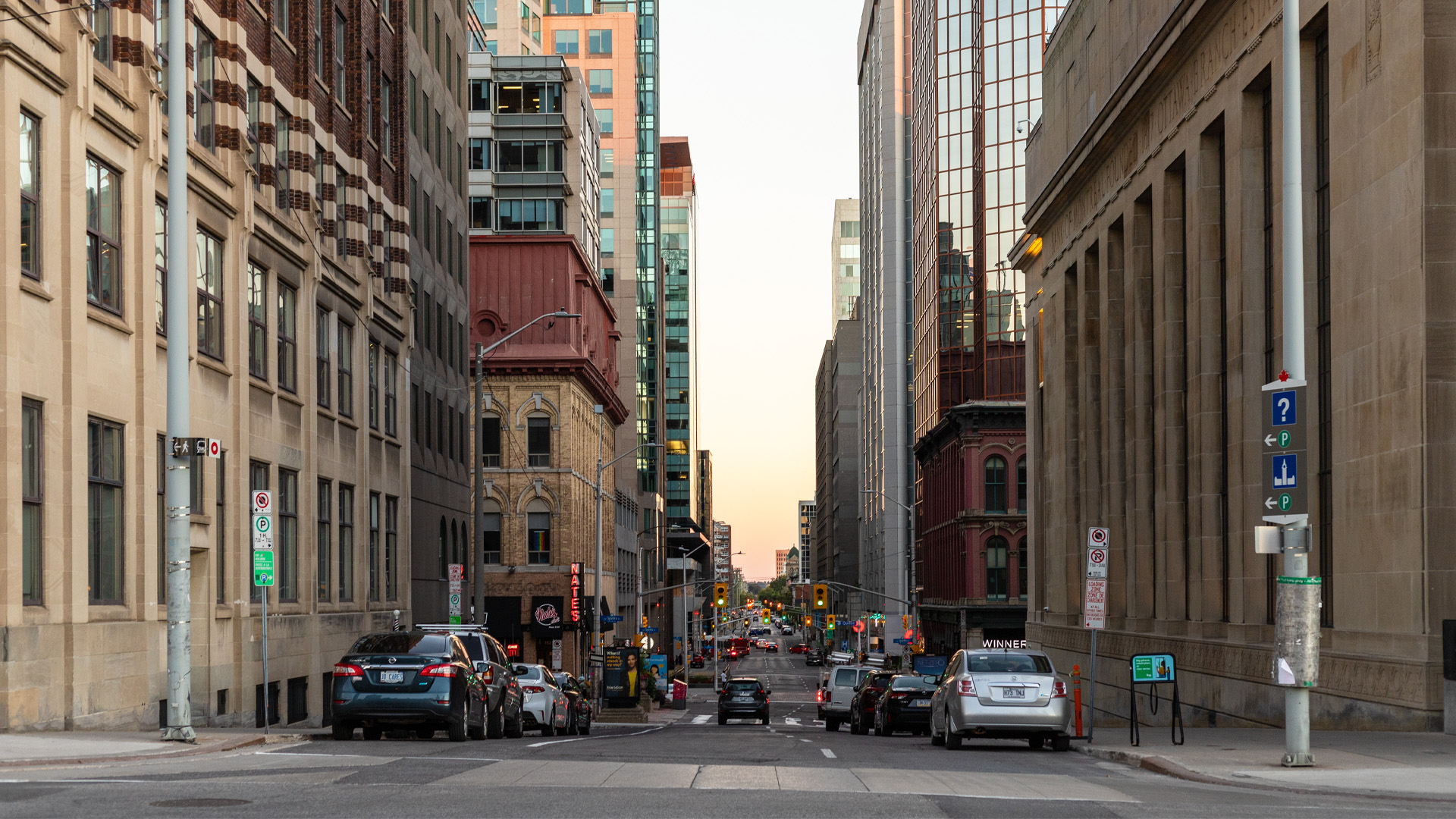
Real estate executive Shawn Hamilton thinks the pandemic that emptied the nation’s capital of thousands of federal bureaucrats could eventually breathe new life into an Ottawa downtown long mocked for “the sidewalks rolling up at four o’clock.”
Despite using the old line to poke fun at his hometown, Hamilton says he has always been bullish on Ottawa. But he and other market experts believe the pandemic has created opportunities to reinvent the downtown with new housing and modern offices, and by selling or converting old and obsolete Crown-owned buildings that now house bureaucrats.
Hamilton is a vice-president of business development with Canderel Group, manager of Constitution Square, a three-tower complex in the heart of downtown Ottawa that seems as empty as it was in March 2020 when public servants were sent home to work and wait out the pandemic.
Rebirth will take time, Hamilton argues, and Ottawa won’t turn into a densely populated, around-the-clock city like New York. However, less reliance on the federal government will pave the way for a downtown where people live and play, not just work.
“I see it as a place for vibrant urban technology businesses, but most importantly, I see dynamic residential, and all that supports residential, in our downtown core,” says Hamilton, who is also president of the Ottawa chapter of the Building and Owners Managers Association.
“That’s the key to us moving from what they call a 12-hour city to – okay, I don’t think we will be a 24-hour city – but we’ll certainly be an 18-hour city. If the federal government decreases and gives some space back, it creates room for other industries to come in here and bring people with them who will be filling that space.”
The pandemic transformed the nation’s capital with an almost overnight shift to remote work, but it could take years before the federal government gets a handle on how and where public servants will be working.
Each department is planning for a hybrid workforce, a mix of office and home. Some have started to slowly bring employees back, but with the Omicron variant, the timing of a full return or anything close to it is anyone’s guess.
But on another track, the government is planning for the future of work. Automation, artificial intelligence, machine learning, digitization, data analytics, green technologies and an all-out talent war could all change work and the office. Could the public service someday be virtual with little need for office space or full-time employees?
It’s an evolution that will permanently change Ottawa: the amount and kind of office space needed; retail and other small business near office towers; and commuting patterns.
No other city will feel the impact of the federal real estate shift like the National Capital Region where the government is the largest employer and landlord. The government employs about 260,000 people in 102 departments occupying 75 million square feet of leased and Crown-owned space across the country.
Half of that is in the National Capital Region, where headquarters for most departments are located and where 140,000 employees went to work pre-pandemic in offices occupying 38 million square feet.
Will nooks and lounges replace the office in the public service?
The pandemic upended the federal workplace. What comes next?
Real estate and market experts say the government will need less space and that what remains will be reshuffled from old Crown-owned or leased buildings downtown toward a network of suburban satellite offices or hubs.
Nathan Smith, senior vice-president and managing director of Cushman & Wakefield, says more hybrid and remote work isn’t a death knell for Ottawa but rather a “rebalancing of the government footprint.”
“They’re extending out of the core or renewing their footprint in locations that make sense. And light rail transit gives them the opportunity to do that outside of the core,” he adds.
Those predictions could change dramatically if political leaders decide to decentralize the public service and spread the well-paid knowledge work across the country, which is much easier to do with remote work.
Transfer underway
Office buildings and hotels converted to apartments, as well as new construction, added more than 3,000 units to the downtown in the past two years – more than the previous two decades.
“What’s happening downtown now is unprecedented,” says Jason Shinder, CEO of District Realty.
Stéphan Déry, the senior bureaucrat overseeing the federal real estate portfolio, says the government will unload big office buildings that are at “at the end of their useful life.” A 2020 Treasury Board report showed more than 30 per cent of Crown-owned office buildings, are in critical or poor conditions.
At the top of the list is L’Esplanade Laurier, a 1970s Crown-owned office complex, which will go up for sale and could be redeveloped into apartments, condominium, office space or a hotel, says Déry, assistant deputy minister of real property services at Public Services and Procurement Canada (PSPC).
The government already had too much office space pre-pandemic. On average, it was occupied 60 per cent of the time. On any given day, 40 per cent of desks sat empty with workers off sick, on vacation, at meetings or working remotely.
PSPC has been reducing its space for years, compressing the square footage per person to 150 square feet from 250 square feet, and taking over floor space devoted to big corner offices and personalized desks for more collaborative space.
But real estate contraction doesn’t mean personnel reduction. Today’s public service is as large as it has been in a decade, growing more than 17 per cent since 2015. Thousands of people hired to work remotely during the pandemic have never seen the inside of an office.
Urban tech firms, led by Shopify, are the second-largest user of space in downtown Ottawa. About 11 per cent of Ottawa’s workforce is now tech-based – greater than San Francisco’s 10 per cent – making it one of the North America’s Top 10 tech hubs.
Ottawa’s population is expected to grow by 20,000 people a year, with a large share coming from immigration. “We’ll be growing with people and a growing tech environment, and all that paints a rosy picture for the city,” Hamilton says.
Shinder says government delays and indecision on bringing workers back to the office has left the region in limbo.
How COVID-19 could reshape the federal public service
COVID-19 and the future of public sector work surveillance
“There’s still no plan, it’s all up in the air and nobody knows. That’s got to be frustrating for government employees. It’s frustrating as a landlord; frustrating for small business owners downtown. This touches a lot of people.”
While they wait, landlords are planning based on a few key trends.
A fraction of federal offices has been modernized into GCworkplace, the open, collaborative, and desk-sharing space design PSPC is rolling out. The disposal of old buildings, along with the rollover of most leases over the next five years will help speed that up.
Can buildings drive a green shift?
The big driving force is the government’s greening strategy for all Crown-owned office buildings to be carbon neutral by 2030.
The government is charging ahead with overhauls of large complexes such as Place du Portage Phase III, Les Terrasses de la Chaudière and Global Affairs Canada’s headquarters, the Lester B. Pearson Building, to help reduce greenhouse gas emissions.
The government also set a target for 75 per cent of its leased building to be carbon neutral by 2030. None comply now. That didn’t stop investors from recently paying $350 million for the massive 50-year-old Place de Ville complex – considered the second largest deal in the city’s history. The government is the main tenant, including Transport Canada, which has indicated a work-from-home policy by default for the foreseeable future.
The easiest way to hit the target is building carbon-neutral buildings from scratch. The government’s model for the zero-carbon office of the future is a new east-end complex at 599 Tremblay Road. It will house 8,000 workers, has access to transit, offers only a little parking and is located near suburbs where employees live.
Some feel the government can’t meet the 2030 target. Failing to lead by example could bring a political backlash and give big landlords an excuse to avoid making their own changes.
An unknown factor
For now, the big question is how many workers come back to the office. Meredith Thatcher, co-founder and workplace strategist at Agile Work Evolutions, says more than half want hybrid jobs so they can work from home. “I know a lot of people don’t believe that. But I think they have blinders on.”
Others, like Smith guess that a quarter of employees will return and three-quarters will divide their time between home and office. After a couple of years, he expects those numbers will flip and 75 per cent will be back at the office and 25 per working between the office and home.
“It’s just not fun. There are always exceptions but no one’s having fun working from home.”
This article was produced with support from the Accenture Fellowship on the Future of the Public Service.









